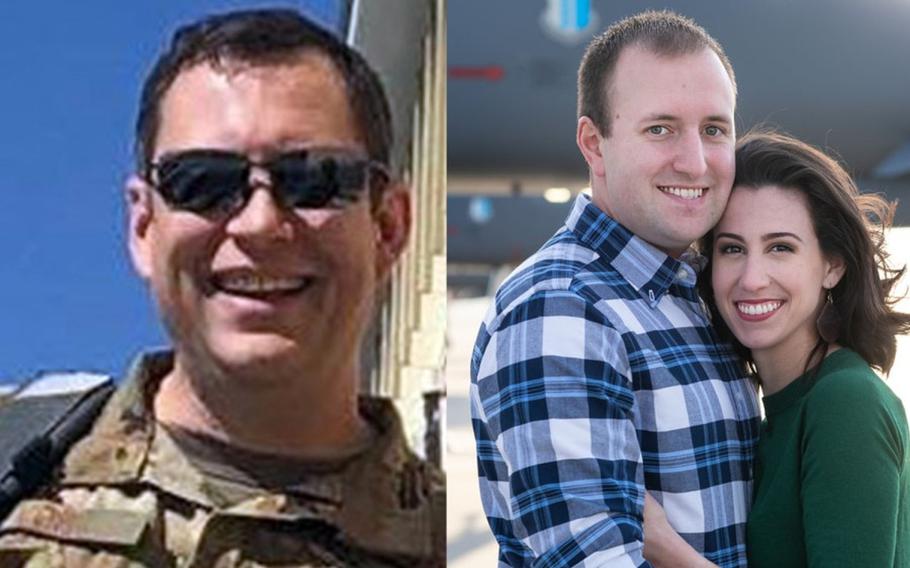
Lt. Col. Paul K. Voss, left, and Capt. Ryan S. Phaneuf, shown here with his wife Megan Murat Phaneuf, died on Jan. 27, 2020, in the crash of a Bombardier E-11A aircraft in Ghazni province, Afghanistan. (U.S. AIR FORCE, JENILYNN PHOTOGRAPHY)
KABUL, Afghanistan — Engine failure combined with pilot error caused the crash of an Air Force jet in Afghanistan that killed two pilots last year, a report on the accident said.
Lt. Col. Paul K. Voss, 46, and Capt. Ryan S. Phaneuf, 30, were the only ones onboard the twin-turbofan Bombardier E-11A aircraft when it went down in central Ghazni province on Jan. 27.
Nearly two hours into their flight, a fan blade broke in the plane’s left engine, causing it to automatically shut down, an Air Force accident investigation report released Thursday said. The pilots then misjudged where the problem was and mistakenly shut down their right engine, it added.
The crew’s failure to restart the right engine and their decision to try to return to Kandahar Airfield without power — which was 265 miles away at the time of the incident — “substantially contributed to the mishap,” the report concluded.
The plane’s cockpit voice recorder included a loud bang when the fan blade broke. But the voice and digital flight recorders stopped working soon afterward, meaning the circumstances of the crash couldn’t be fully determined, the report said.
To compensate for the missing data, investigators referred to a nearly identical incident in 2006, in which that crew reported vibrations of such magnitude after their fan engine blade separated that they thought they had collided with something.
The pilot later said he couldn’t determine which engine had failed based on the vibrations.
The overall vibrations in January’s incident would have been 25% greater than those felt in 2006, “making it more likely the [crew] perceived the event as severe,” the report said.
Their decision to return to Kandahar — which they would have known was well outside their gliding capabilities — suggests they were confident they’d be able to restart one or both engines, the report added.
The pilots were close enough to glide and land at either Bagram or Kabul airports, the report stated.
It’s unknown whether the crew attempted to restart the right engine, but investigators speculated that if they thought it was damaged, they may have only attempted to restart the left one.
The crew made two mayday calls to Kabul air traffic control, informing them that they had lost both engines. One of the calls was made just before they attempted an emergency landing in a field, which destroyed the aircraft and resulted in their deaths, the report said.
Shortly after the crash, the Taliban said its insurgents had downed the plane, a claim the U.S. military immediately refuted.
Voss and Phaneuf were both assigned to the 430th Expeditionary Electronic Combat Squadron at Kandahar Airfield and were conducting a combat sortie in support of Operation Freedom’s Sentinel, the military said.
The 430th is the only unit is the Air Force that operates the E-11A with the Battlefield Airborne Communications Node, or BACN, which allows different communications systems to share and relay video, imagery and data to ground troops.
The E-11A is a U.S. military version of the Bombardier’s popular Global Express business jet.
The crash resulted in damages worth $120 million, the report said.
“This tragic accident and the loss of these two airmen will not be forgotten,” Gen. Mark Kelly, commander of Air Combat Command, said in a statement Thursday. “(They) gave the ultimate sacrifice in service to the nation while deployed supporting an overseas combat mission. They should be recognized and remembered for their dedication and bravery.”
wellman.phillip@stripes.com Twitter: @pwwellman